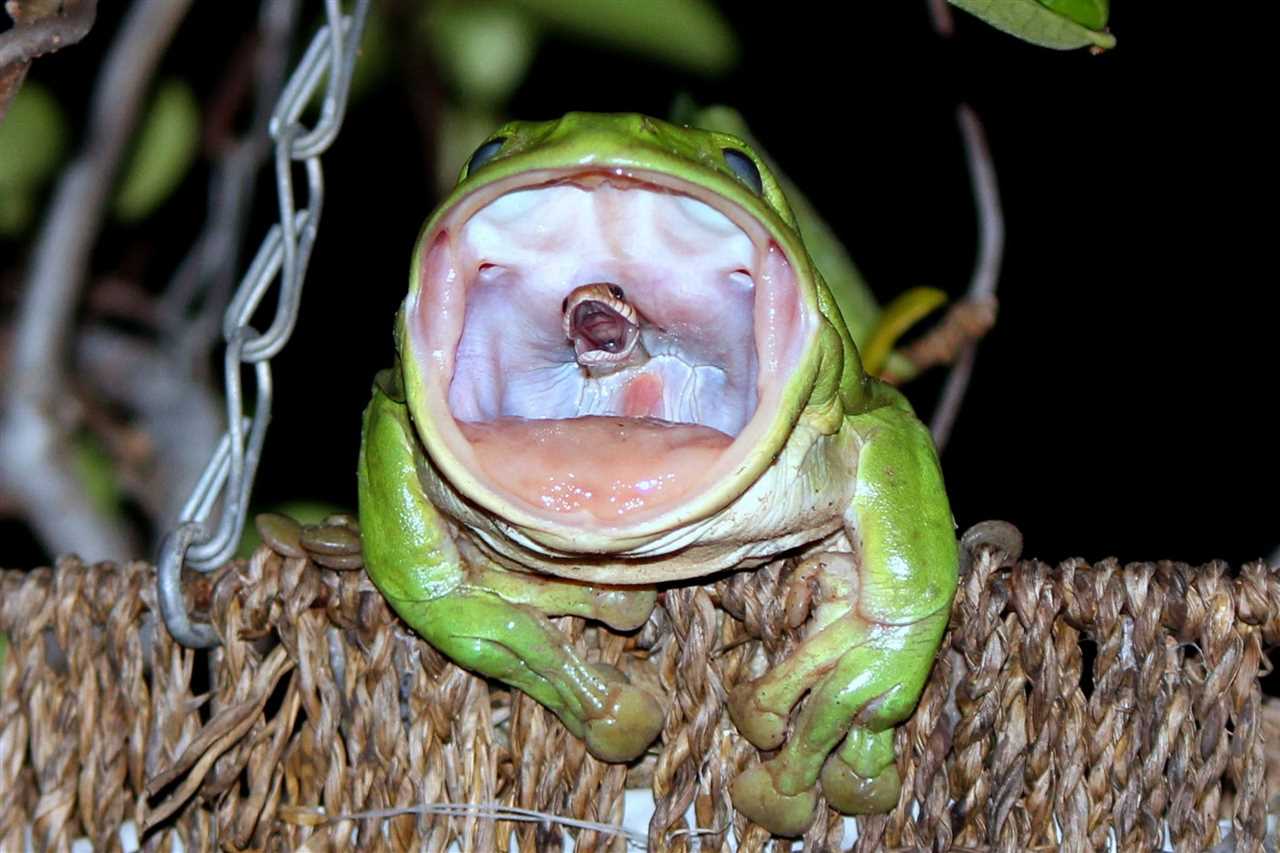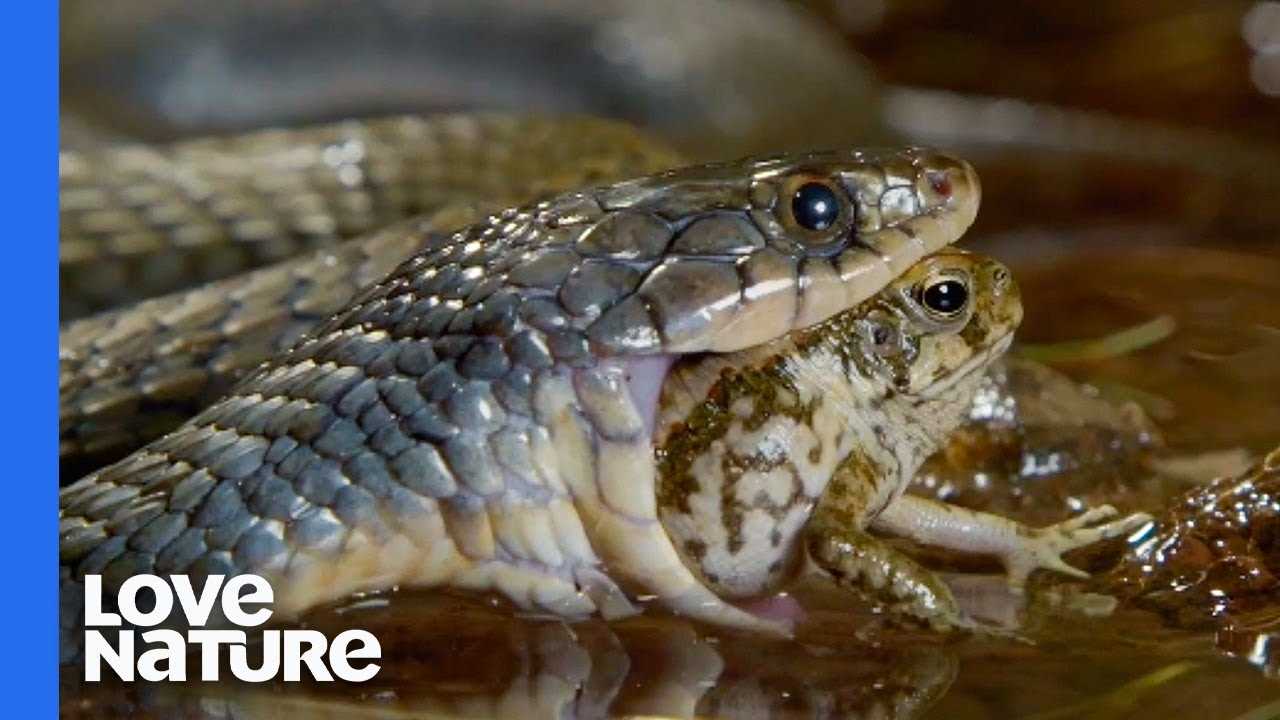
Snakes are fascinating reptiles known for their unique predatory habits. These cold-blooded creatures have a diverse diet, but one of their favorite meals happens to be frogs. This article delves into the intriguing world of snake predation, examining how snakes hunt, capture, and consume their amphibian prey.
Snakes employ a variety of strategies to capture their agile and evasive prey. Some species use venom to immobilize their victims, injecting potent toxins into the frog’s body. Others rely on their powerful constriction abilities, coiling their bodies tightly around the frog to prevent escape. Regardless of the method, snakes are highly effective predators capable of securing a meal even in the face of an active and wary prey.
Types of Snakes that Prey on Frogs
-
Garter Snakes
-
Rat Snakes
Rat snakes are another group of snakes that commonly feed on frogs. These snakes are found in various parts of the world and come in a variety of species. Rat snakes are constrictors, meaning they wrap themselves around their prey and squeeze until the frog becomes immobilized. Once the frog is incapacitated, the snake will swallow it whole.
-
Water Snakes
-
Copperheads

Copperhead snakes are venomous and have a diet that includes frogs among other small animals. These snakes are primarily found in North America and use their venom to immobilize their prey. Copperheads have heat-sensing pits on their heads, which helps them locate prey in low light conditions. Once the frog is bitten, the snake will wait for it to succumb to the venom before consuming it.
Hunting Techniques of Snakes
Snakes are highly skilled hunters that have adapted various techniques to capture their prey, including frogs. These techniques allow snakes to catch their prey efficiently and ensure their survival in diverse habitats.
Swallowing Alive: For smaller snake species, swallowing their prey whole is a common hunting technique. Once the snake captures the frog, it manipulates its jaws and muscular throat to stretch and accommodate the frog’s body. This process is facilitated by the snake’s highly flexible skull and elastic skin that allows it to consume prey larger than its own head size.
Foraging: Some snake species engage in active foraging, actively searching for frogs instead of relying on ambush or prey detection. These snakes use their keen sense of smell and specialized heat-sensing organs, called pit organs, to locate frogs. Once detected, the snake approaches its prey cautiously, strikes, and consumes it.
Overall, snakes have developed an array of hunting techniques to successfully capture and consume frogs as part of their diet. These strategies allow snakes to adapt to various ecological niches, ensuring their survival as predators in frog ecosystems.
Snake Venom and Prey Immobilization
Snakes are well-known for their ability to immobilize and kill their prey using venom. Venom is a highly specialized substance produced by venom glands in the snake’s head. Different species of snakes have different types of venom, which they use to subdue and digest their prey.
When a snake bites its prey, the venom is injected through its hollow fangs into the victim’s body. The venom acts as a potent toxin, disrupting the prey’s nervous system, paralyzing its muscles, and causing a rapid drop in blood pressure. This immobilizes the prey, making it unable to escape or defend itself.
In the case of snakes that prey on frogs, the venom is particularly effective. Frogs are highly sensitive to the toxins found in snake venom, making them easy targets for snake predation. The venom not only immobilizes the frog but also starts the process of digestion.
Once the prey is immobilized, the snake typically swallows it whole. The flexible jaw of the snake allows it to open its mouth wide enough to accommodate prey that is much larger than its own head. The snake uses its muscles to push the prey down its throat, and the digestive process begins.
Snake venom also plays a crucial role in the snake’s digestive system. The enzymes present in the venom help break down the tissues of the prey, making it easier for the snake to absorb the nutrients. This allows snakes to extract maximum nutrition from their prey and survive even in environments where food is scarce.
Eating Frogs: Swallowing and Digestion in Snakes
Snakes have a unique way of eating their prey, including frogs. Once a snake successfully captures its target, it uses its powerful jaws to swallow the frog whole. Unlike other animals that tear flesh or chew, snakes do not have the ability to chew their food, so swallowing prey whole is their only option.
Snakes have an amazing ability to stretch their jaws and body to accommodate prey that is much larger than their head. This is possible due to the loosely connected bones in their skull and a specialized hinge joint in their lower jaw. It allows them to open their mouths wide enough to engulf the prey entirely.
After the frog is swallowed, the snake’s digestive system takes over. The stomach of a snake is highly adapted for breaking down the prey. It secretes extremely potent digestive enzymes that can dissolve the entire prey, including bones. This allows the snake to extract all the nutrients from the frog’s body.
Once the digestion is complete, snakes expel the waste material, which consists mainly of indigestible parts such as bones, skin, and any other non-nutritious components of the prey.
Snakes and Frog Population Control
Frogs serve as a vital food source for snakes, and their predation plays a significant role in controlling frog populations. Snakes have evolved specialized hunting techniques, venom, and digestive systems that allow them to efficiently capture, immobilize, and consume frogs. This predation has a direct impact on the population dynamics of both snakes and frogs.
Venom and Prey Immobilization: Snake venom plays a crucial role in immobilizing frogs before consumption. The venom injected by the snake’s fangs contains enzymes that disrupt the frog’s nervous system, causing paralysis and preventing escape. This immobilization ensures that the snake can consume its prey without any resistance and minimizes the risk of injury during the feeding process.
Swallowing and Digestion: Once the frog is immobilized, the snake employs its unique jaw structure and flexible ligaments to swallow the prey whole. Snakes can stretch their jaws to accommodate prey much larger than themselves. The digestive system of snakes is highly specialized, allowing them to break down and extract nutrients from the entire frog, including bones, muscles, and organs. This efficient digestion ensures that the snake obtains maximum nutritional value from its meal.
The predation of snakes on frogs serves as a means of population control for both species. Large frog populations can have detrimental effects on their ecosystems, leading to competition for resources and potential disruptions in the food chain. By preying on frogs, snakes help regulate their numbers, preventing overpopulation and maintaining ecological balance.
The Impact of Snake Predation on Frog Ecosystems
Ecological Importance
Frogs are important components of many ecosystems, serving as both predators and prey. They play a vital role in controlling insect populations and are an essential food source for many other animals. With snakes being a top predator, their predation on frogs helps regulate their populations, preventing overpopulation from occurring.
Population Control
Snakes help control frog populations by selectively preying on them. This predation keeps the numbers in check, ensuring that the available resources, such as food and habitat, are not overwhelmed by an abundant frog population. Without this control, frog populations could increase rapidly, leading to resource depletion and ecological imbalances.
Additionally, snake predation helps maintain a healthy balance between the various species of frogs. Different snake species have preferences for specific frog species, allowing for the coexistence and survival of a diverse range of frogs. This diversity is crucial for ecosystem stability and resilience.
Indirect Effects
The predation of snakes on frogs also indirectly influences other organisms within the ecosystem. For example, when frogs are consumed by snakes, their habitats may experience a reduction in frog-related activities, such as mating calls and tadpole activity. This change in behavior can affect other species that rely on these cues for their survival and reproduction.
Furthermore, the presence of snakes in frog habitats can induce behavioral changes in frogs, such as altered feeding patterns and hiding behaviors. These adaptations can have cascading effects on the abundance and distribution of other organisms within the ecosystem.
Ecosystem Stability
The interaction between snakes and frogs is essential for maintaining the stability of frog ecosystems. Snakes not only regulate frog populations but also contribute to the overall health and diversity of the ecosystem. By controlling frog populations, snakes help maintain suitable conditions for other organisms, promoting a balanced and thriving ecosystem.
Conservation Considerations
Conservation Efforts for Snake and Frog Habitats
Snakes, as predators, play an important role in the ecosystem by regulating the population of their prey, including frogs. However, due to habitat loss, pollution, and the illegal pet trade, both snakes and frogs are facing significant threats to their survival.
Conservation efforts for snake and frog habitats are crucial to ensure the continued existence of these species. One important step is the preservation and restoration of their natural habitats. This involves protecting wetlands, forests, and other areas where snakes and frogs reside.
Another key aspect of conservation is raising awareness about the importance of snakes and frogs in the ecosystem. By educating the public about the ecological roles these animals play, efforts can be made to reduce negative attitudes towards them and promote their conservation.
Furthermore, implementing strict regulations and laws against capturing and trading both snakes and frogs is essential. This can help curb the illegal pet trade and prevent the overexploitation of these species.
Collaborative efforts between scientists, conservation organizations, and local communities are also necessary to ensure the success of conservation initiatives. By sharing knowledge, resources, and expertise, these groups can work together to protect snake and frog habitats.
In addition, establishing protected areas, such as national parks and wildlife sanctuaries, can provide a safe haven for snakes and frogs to thrive. These areas can be designated specifically for the conservation of these species and their habitats.
Overall, the conservation of snake and frog habitats is crucial for maintaining the balance of ecosystems. By protecting and preserving these habitats, we not only ensure the survival of these species but also contribute to the overall health and diversity of the natural world.

I’m Lena Adams—a product of an unconventional upbringing in the African wilderness. My father, a daring explorer of African wildlife, sparked my fascination with reptiles, a passion that intertwined with the tragic loss of my mother during an expedition, leaving an indelible mark on my life. Driven to understand the creatures that captivated my parents, I embarked on my journey, sharing insights about reptiles, frogs, and lizards on my website. Through my explorations and conservation efforts, I honour my family’s legacy while seeking connections—to the creatures, nature, and the mother whose presence I yearn to understand.
